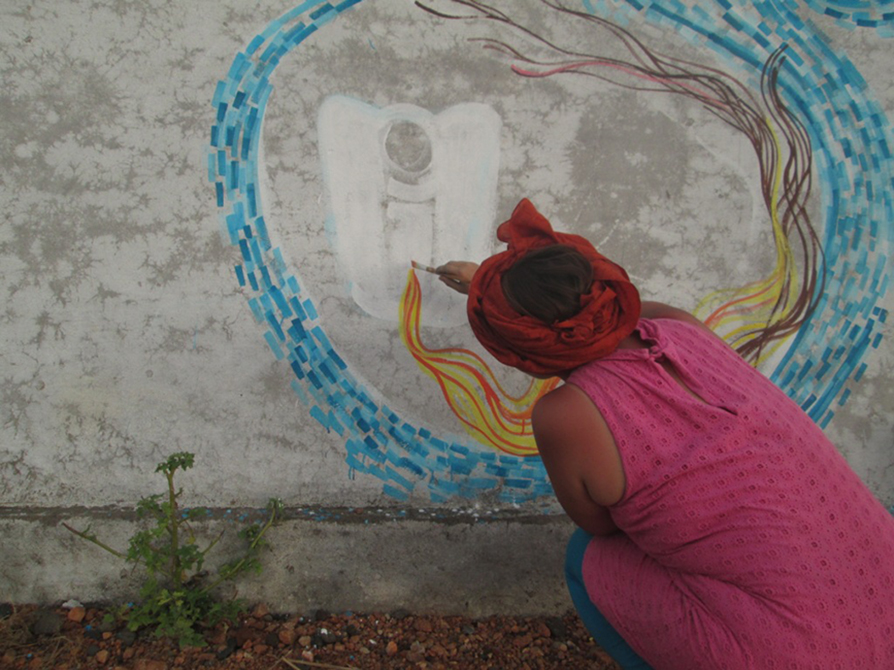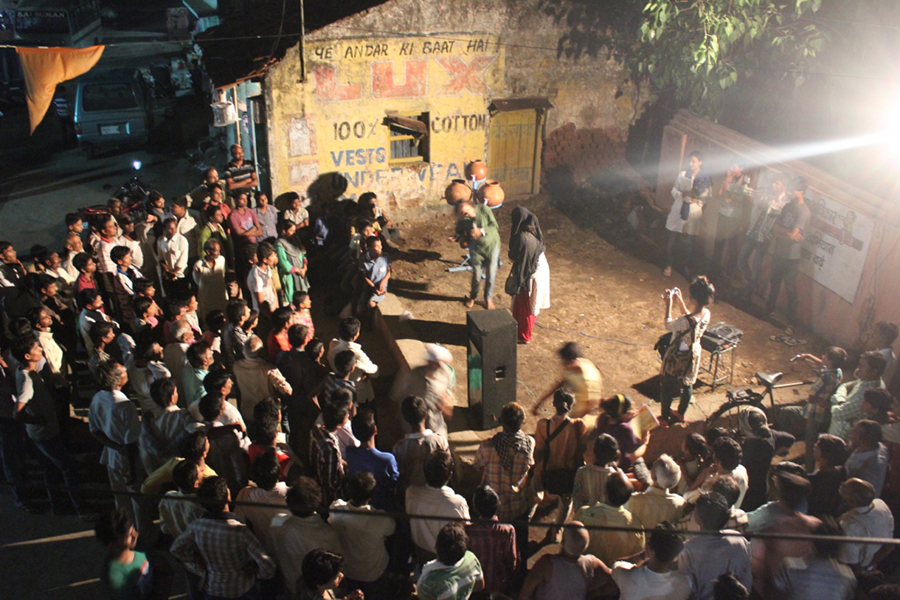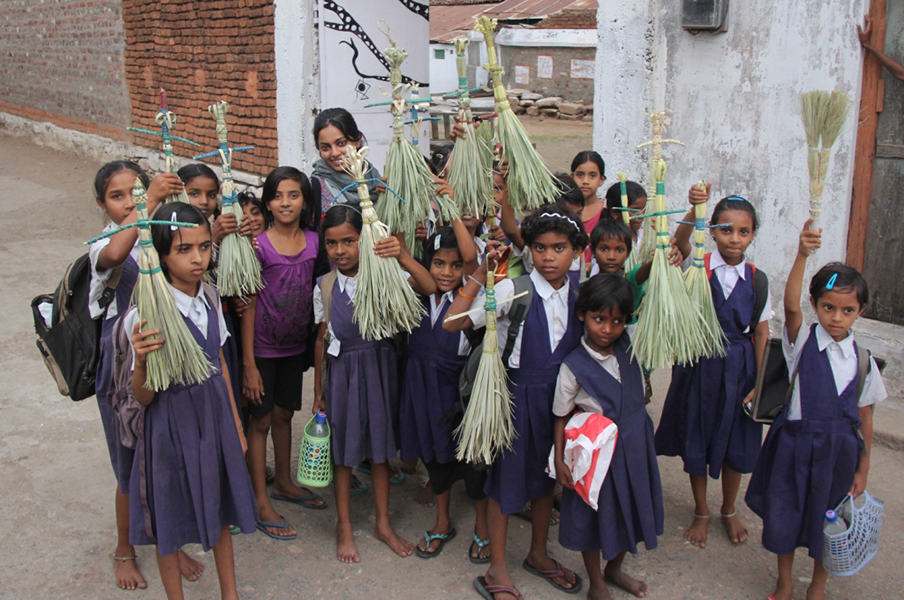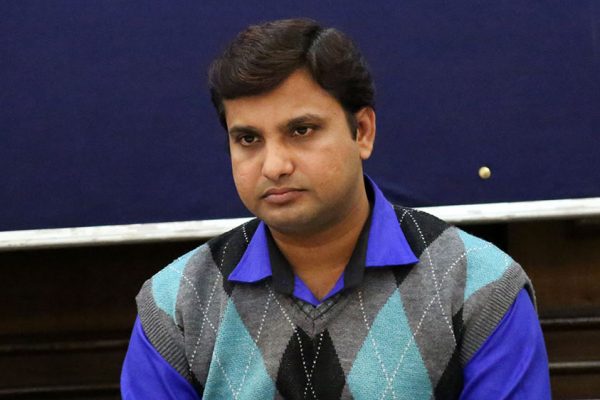To bring about a change in the way rural India thinks and aid them in enabling better sanitation methods, the Gram Art Project conducted a ten-day event in Paradsinga village in Madhya Pradesh. Samudra Kajal Saikia has all details from this interesting initiative.
Shakti Bhatt, who lives and works in Baroda has been taking up projects related to water management in several parts of the country. When he comes in contact with Gram Art Project in Paradsinga Village in Madhya Pradesh,the meeting of creative people, concerned resource persons and the rural communities form up a residency program with new directions.
Gram Art Project is working with rural communities with a central concern to give sustainable solutions for day-to-day human life & ecological needs. Gram is based in Paradsinga Village of Madhya Pradesh, which has a population of 4,000 people and approximately 1,000 homes, out of which only 30% of the families have toilets while the remaining 70% of the families defecate outside in public.
The team of Gram observed that the village is facing a very severe scarcity of fresh water. These conventional toilets require a very huge amount of fresh water for cleansing and flushing purposes and all this waste is dumped into the village river further contaminating it. This contaminated and hazardous water is consumed by the villagers and the animals which result in various diseases and makes their life miserable. Thus, the artists’ team started working on an ecological solution to save the river water from contamination. Shakti Bhatt tries to attract attention to the fact that we do not understand the meaning of the word sanitation. Sanitation does not only mean throwing the waste away. Good sanitation is that where minimum water is required, and which can be reused. After consulting people who are already working on sanitation issues, a sustainable solution – the Eco-Sani-Irri (Ecological-Sanitation-Irrigation) is undertaken.
To spread awareness about the importance of Eco-San-toilets and the use of recycled water for irrigation purposes among the villagers, Gram invited artists from several parts of the country and the world. There was a ten-day event between 11 June and 20 June 2014 with active participation of ten different artists across the village. During those 10 days stay, artists collaborated with local villagers and created awareness among them through performances, theater, storytelling, poster making and different kinds of media which communicates better and effectively works with the villagers. Before starting construction work and residency, Gram has done some ground work like soil sample collection and water analysis, meeting with villagers, farmers, women, youth and conducting workshops and awareness programs about health & sanitation.
Gram together with all the invited artists spent long sessions in discussing the issues and concerns regarding Eco-Sani-Irri toilets. They also discussed the viability and sustainability of their projects. Although most of the artists had proposed specific working methods when they applied for the residency, it was very interesting to notice how some of the ideas and concepts were conceived, developed further and even entirely changed during the discussions. The core which the artist had come up with went through a series of changes and transformations. The change in landscape and cultural surroundings is bound to have its own effect in the minds of the artists.
Katarina Rasic from Serbia came with a basic idea of making a water purification system and said that it could be developed further by seeing what local techniques the villagers use in their houses. She wants to make a simple water filter with stone, charcoal and sand. If possible, she would also make the filter in the playground. We gave her the suggestion that we would write some messages about sanitation and water management. She also proposed the idea of making an installation in the playground with garbage. We all suggested her that we could also think about making graffiti on the walls of the toilet of the school taking reference from the school text books of Environmental Science.
While working among the public she realised, “I thinkonly the information is missing for them, because when I told them they accepted it quite well. When I was making the system they were very interested in finding out how it worked. Maybe they have internet but they didn’t Google it”. She felt that spreading awareness was therefore the key objective.
Other than installing a water purification system in public, Katarina Rasic also drew two murals, one on the wall of the toilet in the school and the other in the heart of the market place. However, being a visual artist she was not only concerned with the images or the shapes, but with the reactions of the spectators and the impact afterwards. “What I’d like to find out – what is there after we leave? Did they use something of it? If they got something from it? How they developed it? Did they think at all? Whether we’ve actually done something or not, whether it is going to be executed in a practical search – is the most important thing.”
Kalyani Uday from Mumbai came to the residency with some basic issues and concerns around which she wanted to work. Being in the village, she came to see the male domination as it functions at Paradsinga. In her opinion this was not very different from what happened in other small towns. She has noted the fact that in spite of having a Sarpanch who is a woman, it is her husband who takes major decisions and handles the work that has to happen in the village. Kalyani wishes to address the issue of eve teasing that happens in Paradsinga. For this she did a small survey in the village tracing the probable spots of eve teasing and getting hold of young village boys who are involved in such activities. She wanted to help the women feel safer at night in dingy corners of the streets of the village. By talking to males involved in such activities she said that she wanted to bridge the communication gap between men and women. Kalyani was of the opinion that through folk singing and bhajans similar messages can be given to the local population. She would think on how these messages can be converted to little rhymes which can be sung in a group performance.
She went door to door talking to people, addressing individuals across the village. She organised a public gathering at the market place and explained the sanitation system and water management possibilities. She initiated a venture with wall graffiti, writing on the public walls. She also celebrated a mock ritual “Toilet Worshipping” where villagers came and worshiped an eco-toilet, which became a source of immense fun for the villagers.
Within the larger project of Eco-Sani-Irri Jinal Patel, an artist from Ahmedabad came with a definite objective of working on sanitation. Marking the issue of menstruation as a central objective, the idea was to engage with girls in puberty. Jinal also suggested that the drawing workshop and story-telling sessions on body and hygiene could help unknot hesitation amongst girls about the internal and external changes in their body. Her idea was to address issues of hygiene and sanitation introduce traditional games, and songs about menstruation within the village. The idea was also to make women aware of their association with nature. She gathered young girls and started exploring some games and rituals which could explain the details around the bodily changes in a woman in the phase of puberty.
 Kalyani Uday addressing the public
Kalyani Uday addressing the public
“Even in the urban scenario menstruation is like a taboo to talk about. In a village, I would like to know what is the scene. I started with a game – it has something to do with the puberty rituals. I used some drawings to make the young girls understand the next phase of their body. While playing the game you can discuss about the facts, and a lot of interesting facts came up about the local area, which I cannot imagine”, Jinal adds.
With her background in literature and interest in the creative arts Srishti, from Assam, has proposed one the finest ideas. She proposed to make a wall magazine with the young people in the village. The idea has extreme potential because it has the power to unearth creative abilities and at the same time is of a sustainable nature. This Wall Magazine can allow the creative potentials to nurture and flourish in the village. The basic idea is to collect articles, short poems, drawings, jokes etc. from the children and other people in the village. This will also help to bridge the gap between older and the newer generation in the village. The idea of the Wall Magazine did not end at collecting material but forming a committee to carry out the Wall Magazine on a regular basis. Referring to the idea of ‘little magazine’ which were used for propagandist reasons in the leftist revolution, this Wall Magazine will create an awareness about ecology, sanitation and irrigation. This was one of the most sustainable projects proposed which could easily be taken forward.
Finally “Jaan Kanhaan”, a wall magazine was published and the magazine is being continued by the people of the village even after the artists have left the village.
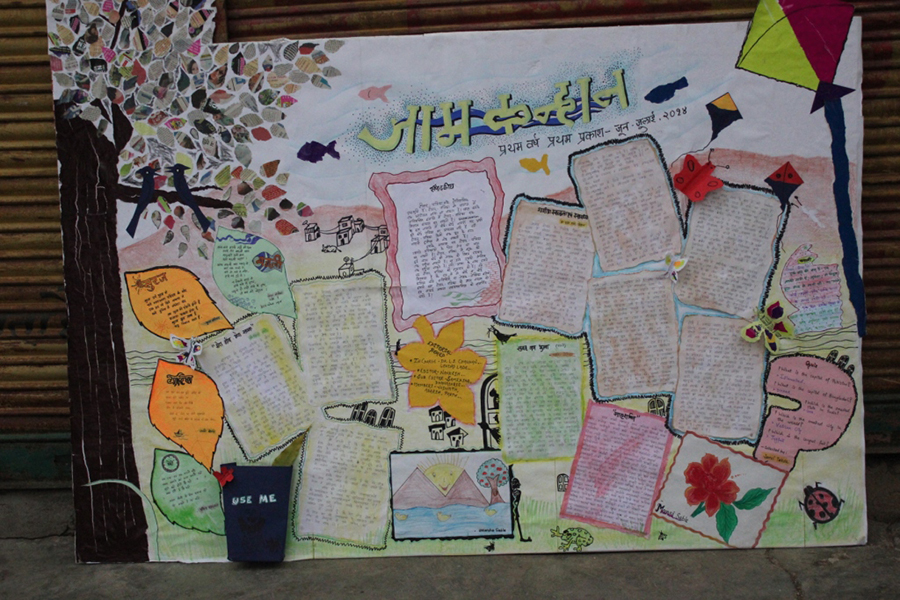 Jaam-Kanhaan_ the wall magazine
Jaam-Kanhaan_ the wall magazine
Kriti Gupta from Jaipur, Rajasthan, took a community interactive art project where she explored the social positioning of the broom maker community, their craftsmanship and the hardship of the local craft. She was particularly intrigued by the broom making community living on the outer circles of the village. Although broom is an everyday object in every household yet it has a stigma attached to it. The basic idea was to work with children whose minds are still naïve and who do not understand differences based on social inequality.
“Broom or jharu is all about taking away the dust and dirt and everything. I started visiting the community that involved with this living craft. It appeared very interesting to see that they make brooms out of palm leaf which they get from across the river. The whole thing is made by the ropes that are made out of the leaves. It is hand work, a skill,” the artist says.
The artist wanted to explore the art of broom making and the beautifully woven palm leaves. She started making some dolls out of the brooms and initiated a workshop with the people from the community. She involved the children of the village and they enjoyed the process. As Gupta visited the village, she was concerned about the social structure. “I was just thinking”, Gupta says, “how it was still not convenient for people to include this community in their circle. They are still situated right in the outer circle- the way the village is constructed. There are circles within the village, and Untouchable and Dalit communities would always be in the outermost circle”.
Gupta started gathering the children, playing with them and initiating workshops where they would learn making broom-dolls. “I thought”, Gupta says, “how the children and the broom could be related. It may not be an interesting object to have for a kid. So broom, its shape and form itself could tell us of the opportunities and possibilities of turning it into a doll – that every child would want to have”. And it worked out nicely. The children enjoyed the art of making broom-dolls and during the process the community people also shared their thoughts with the artists.
Hamida Khatri from Pakistan works mainly with the human form and the body. Her main area of interest is puppets, and she wanted to create along with the other village members, puppets made out of the material available there.
“We came up with an exercise which involved the children and the villagers together. The simple game was a basic idea to create awareness among the villagers and the kids.” Hamida says. “I’m a visual artist and make smaller puppets. We thought why not make it a life-size puppet – which is very moveable and something fun for the villagers to do. So, the idea was to educate people how to sit on a toilet seat, and the toilet was the Eco-Sani toilet which we’re trying to bring to this village, hopefully it works.”
Sadya Mizan from Bangladesh works mainly with architectural forms. Here, during the residency she says that her concern is illustrating the problems of the villagers through an installation or some other interesting form or medium. She has also proposed to create spaces and places where a healthy environment could be created for prospering womanhood in the village without the fear of male dominance.
“There are some facts which they are taking for granted, as not having a toilet. Going to open toilet, in the fields – is irritating and disturbing. They just don’t care about it. After talking to people, I realised how they think about life. Private things and activities shouldn’t be out in the public place, it might get disturbing and that is not something you should do. I created some toilets out of material I found in some of the houses of the village. I’ve collected some bamboos and sticks from around the village and some sarees from the local people. I put a diagram of the Eco-Sani-Irri out there through which they can think of using the toilet.”
“You are wearing clothes, going out in a proper way but for a toilet you are going outside.
Your sisters, mothers, the women of the house go outside the houses showing their private parts, showing their private garments – that is what is actually happening. When I put it all together in front of your eyes, you are feeling disturbed. That is what you are doing in everyday life. Everybody is getting disturbed already but it is not good to use the public place because the toilet is your private place, and a public place is a public place, there you don’t do your private things like this.”
I dropped the idea of doing a disposable theatre which I had planned initially and spent my time roaming around, meeting people and observing what was happening.. I came up with an illustrated book, “Andaaz-e-Sandaas” to increase interest in toilets which was the central concern of the “Eco-Sani-Irri” residency program. Towards the end of the residency, he initiated a performance-based event across the village which was called “Jhini Jhini Chadariya”. It was a piece of cloth that travelled door to door.
The artists and local participants celebrated a mock-ritual visiting each and every household on a rainy day offering a sanitation-book, a demo leaflet on water purification, a seed covered with mud and cow dung, shaped like a toy to the households and in return asking for something that they would willingly like to offer back. Then they also asked them to make some marks on the white cloth, the chadar we were carrying, referring to the phrase from Kabir’s song: “sur-nar-muni sab ne hi odi, oud ke maili kini chadariya”.
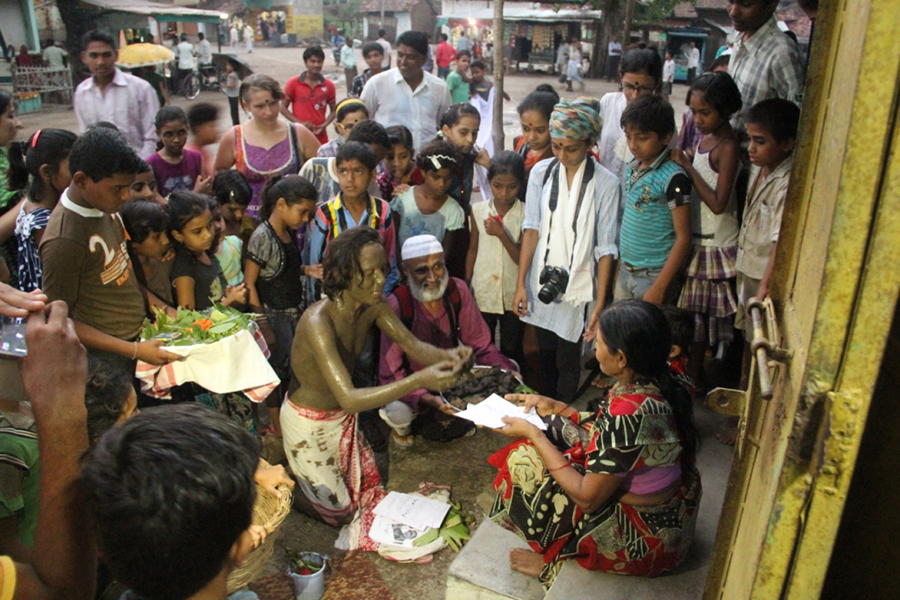 Samudra Kajal Saikia Performing Jhini Jhini Chadariya
Samudra Kajal Saikia Performing Jhini Jhini Chadariya
Finally the procession reached the playground near the flowing stream. All the people, both children and adults, held a cow-dung-covered-seed and recited an Ute prayer, “Earth Teach Me”. Then they threw all the seeds randomly in the field. It was raining heavily and because of that the procession got a different dimension. Nature helped the event, because they were talking about ecology, water, river, seeds, trees, mud and the body made up of soil, somehow the sky also wanted to join the procession. The procession of the artists ended, the procession of clouds in the sky still continued.
Komal Pandey from Lucknow was engaged in the documentation of what was happening around. She was actively surveing the village , consulting with each of the artists, initiating dialogue. She played with the children, made scripts with poetry and songs and prepared performances for the public. She kept the entire series of events more lively with poetry, dance and other interactive performances.
Shakti Bhatt from Baroda remains the major driving force in the artists’ initiative around sanitation and water management. “No one can help anybody. If I create a problem I have to solve it. Who will solve it and moreover how is it possible for anyone to help the other without being in the same position”. This was Shakti Bhatt’s philosophy. He also emphasized that ‘High Tech is not always the Right Tech’ and elaborated by saying that a wonderful commode and glazed tiles are not sanitation. He said that everyone involved with this project will have to know and understand that sanitation is different for the urban space and rural space.
Bhatt says that, “My attempt remains to initiate a dialogue. All should come to together to carry on the dialogue. Microbiologist, pathologist, architect and civil engineer – until they come to a common ground to talk- a dialogue can’t take place. I always wanted to do something, bringing all into one.”
In his notion, “An artist can’t solve the problems today. The situations are not inclusive to a singular faculty or discipline anymore. Everyone should come and sit together to think, and should start working together. It is not must, it is a requirement. Then we can see a better future.”
He talks about his experience with the artists, “I’ve attended many residencies as a translator. Usually what happens is that the money is over, the event is over and thus the residency is over. There is no attempt to connect with the mass. Here the artists took it to a new direction, dialogues began…
It’s a good beginning. I’m trying to connect with the artists if they talk on health, sanitation or agriculture. I’ve never seen artists coming out together this way before.”
Shweta Bhattad from Nagpur initiates the Gram Project at Paradsinga. She says, “One good thing was that many youth participated here. Majority of youth came to know about the projects, they also worked with us for the entire ten days of the residency.”
“What is next after exhibiting a work in a gallery? This kind of thought lead me to performance in public. After performing in public I realized if I want to work with some concerns and already there are people working with such concerns, if a collaboration happens, then the work could be continued ahead. It is not that, once it is done, it is done. It can be taken ahead. You can see the progression- how the movement is happening”.
Lalit Vikamshi and Alag Angle remained another driving force behind the initiative. Alag Angle is an open art space for anyone who loves to create and experience art which encourages, experiments, innovations, sharing, discussions and most importantly encourages all to ask questions.
Starting from sanitation and water management issues the artists’ initiative started dialogues around many other matters that include taboos around menstruation, caste and class issues, health, public and private behavior and many more. The Gram Art Project artists residency program entitled as ‘Ecology-Sanitation-Irrigation’ was under ‘Negotiating Routes : Ecologies of the Byways-V, Khoj’.













